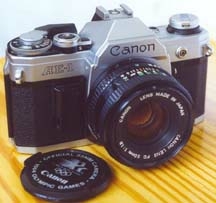
Canon AE-1 #1559858 |
The Canon AE-1 was introduced in 1976 as the replacement for
the FTb. The introduction of this new camera marked a complete departure
from earlier designs in the Canon line.
Although this camera is the first in the Canon line to feature electronic
shutter speed control, it is not the first Canon SLR to offer exposure
automation. Canon's first auto-exposure SLR was the
EX EE (also sold as
the Bell & Howell Auto 35 / Reflex), which was first available in
1969. The EF, introduced in 1972, was the first Canon SLR to offer both
exposure automation and fully interchangeable lenses.
|
The most obvious difference between the AE-1 and older Canon SLRs is
its size. The AE-1 is much smaller. This is Canon's response to a
trend that began with the introduction of the Olympus OM-1, several
years earlier.
The automatic exposure control of the AE-1 is the shutter-priority type,
meaning that the photographer selects the shutter speed and the camera
selects the lens aperture. The available shutter speeds are 1/1000 to
2 seconds, with a separate B setting. There is, however, no exposure
automation for the B setting: the intelligence of the AE-1 is non-prescient.
The shutter speed selection dial, as well as the film speed selector, is
concentric with the film advance lever. Selecting the film speed requires
the photographer to lift and turn the knurled ring that surrounds the
shutter speed selector. This operation is facilitated by first moving the
tip of the film advance lever away from the camera body.
New Lenses
Concurrent with the introduction of the AE-1, Canon introduced a new series
of lenses. These new lenses, the FDn series, differed only minimally
from the earlier FD series. The differences are
- the locking ring of the earlier FD lenses is eliminated,
- many lenses incorporate new designs with smaller components, and
- plastic is substituted for metal in some components (notably the
lens barrels) to lessen weight.
Exposure automation is selected by setting the aperture selection dial
to the A setting.
To mount one of the newer FDn lenses on a camera body, the
photographer would attach the lens to the body by aligning a red dot
on the lens with another red dot on the camera body, and then turning
the lens in a clockwise direction to lock the lens in place. The older
FD series lenses mount in the same manner except that instead of turning
the whole lens, the photographer would turn a locking ring attached to the
lens.
All FDn lenses may be used on older cameras that were designed for
FL and FD series lenses and are equal in function to the lenses that were
designed for those cameras. Curiously, many FD series lenses can be used
on the AE-1 (as well as the A-1 and AE-1 Program) and are fully functional
on the newer cameras, even supporting exposure automation. FD series lenses
that support exposure automation incorporate theta symbol on the
aperture selection dial, which is identical to the A setting on
FDn lenses.
|

